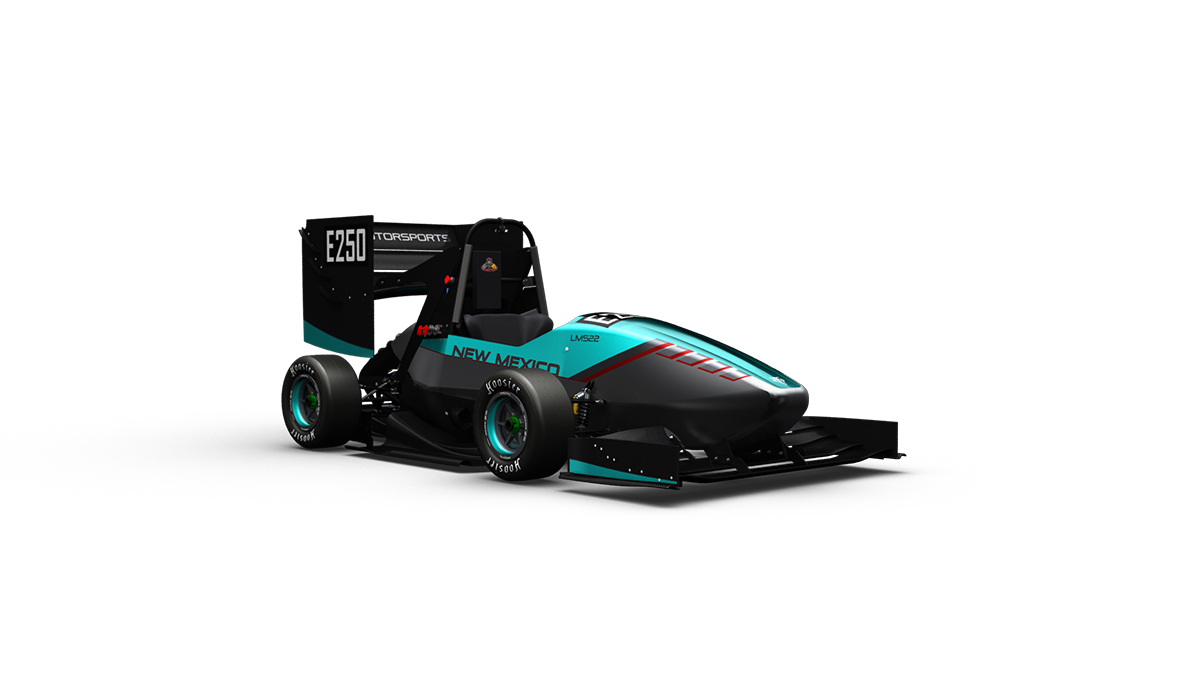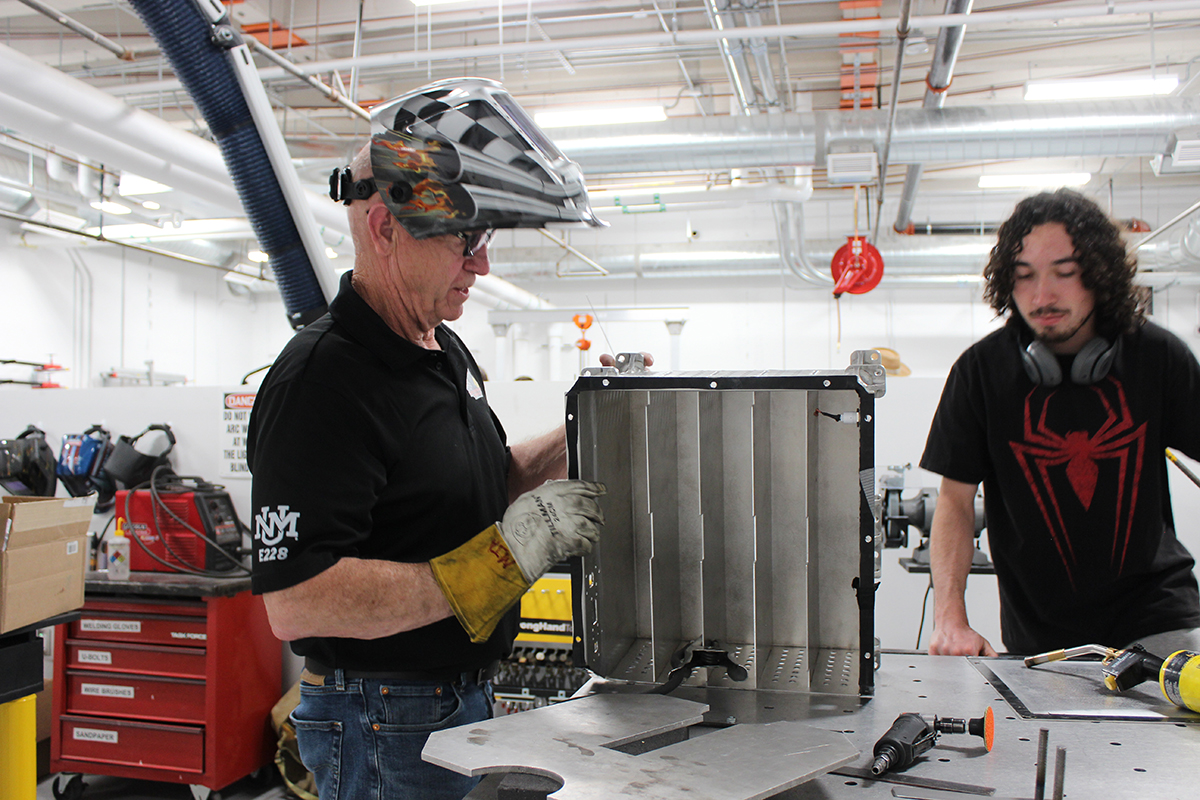Recent News
UNM Engineering Ph.D. candidate named ASCE ‘24 Outstanding Reviewer
August 11, 2025
UNM joins Brown University in national institute focused on intuitive, trustworthy AI assistants
August 6, 2025
UNM Engineering team wins ASEE best paper for work on first-year engineering course
July 17, 2025
New director will enhance interdisciplinary engineering learning opportunities
July 2, 2025
News Archives
It’s electrifying: UNM’s FSAE team to compete in its first EV contest
May 16, 2022 - by Kim Delker

A preview of the exterior of the 2022 EV.
There is a quiet hum in the Dana C. Wood FSAE Racing Lab and Garage these days. Not only is it the end of the semester, but it’s also crunch time.
Competition is about a month away, and there is a lot left to do.
Since 1998, The University of New Mexico has competed in the Formula SAE international competition, which has recently been in Lincoln, Neb. The three-semester program, based in the Department of Mechanical Engineering, has been open to students in any major but tends to attract mainly those in mechanical engineering and electrical engineering. Gears, drivetrains and internal combustion engines have been central to the competition. But this year, things are a bit different.
This year marks the first year that the LOBOmotorsports team will be racing an electric vehicle (EV) instead of an internal combustion car. And it’s safe to say that for most of the team, it’s a bit of a learning curve.
The team will be making the trek to Michigan International Speedway near Brooklyn, Mich., a suburb of “motor city” Detroit. The June 15-18 competition includes 58 collegiate teams from around the world.
Since the car is still being built, the team is getting a later start driving and testing, which they usually do Saturday mornings at the UNM G parking lot on University Boulevard. John Russell, professor of mechanical engineering and director of the program, said that the team has been practicing driving regardless, using previous years’ cars so the team can get driving experience.
“The electric car does handle differently than the internal combustion car, so they will have to get familiar with that before competition,” Russell said.

Students collaborate on the EV build in the Dana C. Wood FSAE Racing Lab and Garage.
He expects the EV to be ready for a test run very soon. See the 2021 test EV in action at the G lot.
This year, instead of a gas tank to fill, the car has 720 batteries that must work together perfectly to power the car with 370 volts of electricity. If just one battery is malfunctioning, it could throw the whole system off, much like a string of holiday tree lights.
“These are the same type of batteries that run a Tesla, except that a Tesla has around 7,000 and we have 720,” he said.Competition rules limit the car’s output to 80 kW.
Russell said that the internal combustion car was complex, but the EV model is even more so. For one thing, the team must have two battery sets because the car will only run about one hour at practice before needing a charge, so a second battery-powered motor must be ready to be subbed in. And since the electric components are sensitive to water, the car must be extensively tested to ensure water can’t get into the electric motor or batteries.
That, and the fact that the battery management system and other electric components are more expensive, means that the EV costs more to build. Russell estimated that the total cost of the electric car powertrain will be about $25,000, whereas the internal combustion version was around $13,000.
“Now fundraising is more important than ever,” he said.
About a half-dozen students on this year’s team are electrical engineering majors, and under the direction of Gene Kallenbach, who is teaching the ECE 419 course, designed the circuit boards that the mechanical engineering students connect.
Mechanical engineering senior Mario Burgarello said he was thankful for the addition of electrical engineers to the team, without whom they would have been very lost.
“The EEs made the boards, then we had to build what they designed,” he said.
Burgarello, who is headed to law school at UNM after graduation to pursue a career in patent law, calls the EV project both “exciting and scary.”
Even Mike Arnold, an experienced shop manager who worked with the famed Al Unser Jr. on the Indy Car circuit for many years before joining the FSAE team at UNM in 2017, said he too is essentially a student in this process.
“I didn’t know anything about EVs, but I am learning along with them,” he said, as he worked with a student on the battery accumulator.
Despite the newness and the challenge, this year’s team also has an advantage, working in the new Dana C. Wood FSAE Racing Lab and Garage, which officially opened in fall 2021, thanks to a $1.5 million gift from the Wood family. The 8,000-square-foot space includes new equipment and space, like a dedicated EV lab, a water jet cutter, a composites room, a design and collaboration room and simply more total working space.
Team members say the water jet cutter, which was ordered almost a year ago with the original Wood family donation funds, arrived this spring and gives the team a huge advantage in being able to make parts they need in short order. The machine works off of computer-aided design files.
“We can make parts here in the shop in 10 minutes for what used to take a couple of hours at an outside shop,” Burgarello said.

Mike Arnold works with a student on the battery accumulator.
Senior Joaquin Espita said that the composites room is allowing the team to produce most of their carbon fiber exterior components in-house instead of sending them out. This saves both time and money, and allows the team to understand how composites are made.
New this year, thanks to the composites lab, is the ability to make Kevlar panels for the car.
“No one has done Kevlar before in competition,” Espita said. “It is strong but extremely lightweight. It’s the same material that bulletproof vests are made of.”
Another plus for UNM’s team is that it has around 25 years of history and winning behind it, along with the organization that sets it up for success. The team competed last year in Las Vegas, Nev., where it took top 10 honors in the virtual FSAE Knowledge Event in 2021. UNM’s EV car finished No. 1 in the presentation category, No. 7 in design and No. 7 overall.
Regardless of how the team performs at competition, the true goal of the program is student learning, and this year’s crop is learning a lot.
Lana Hoover, a senior in mechanical engineering, said she joined the FSAE team at the beginning of the 2021-22 school year not knowing much about electrical engineering past the required circuits course every engineering student is required to take. But even though building an EV car was all new for her, she absorbed the knowledge, and now it is paying off. She will be one of the students traveling to competition in June, and in early July, she will move to Palo Alto, Calif., to take an engineering job at Tesla.
“I didn’t know anything about EVs before last August, but everything I learned here helped me get a job at Tesla,” Hoover said. “A year ago, that would not have been possible. This program definitely prepared me for the job I have now.”
The Formula SAE program is funded almost entirely through private donations. Contributions can be made online.
